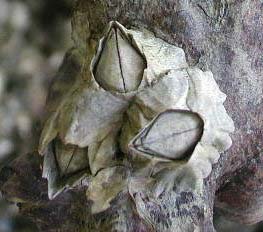Barnacles
Key Characters
Barnacles are identified by the arrangement of the shell plates situated in a ring around the orifice, the shapes of the paired opercular plates filling the orifice, and by features of the body such as the teeth on the mandibles (mouthparts).
Identification to species typically requires dissection but common species can be recognised without the need to dissect. A key feature distinguishing two major families of sessile barnacles is the arrangement of the shell plates of which there are typically 6, reduced by loss or fusion from an original number of 8. Barnacles such as Balanus have fused some plates so that the shell plate at the bottom of the diamond or kite-shaped orifice (the rostral plate) overlaps the two on either side. Barnacles such as Chthamalus or Euraphia have achieved a reduction to 6 shell plates by loss of two shell
plates elsewhere in the ring, leaving the rostral plate overlapped by those on either side.
| Balanus amphitrite | Balanus patelliformis |
 |
|
 |

